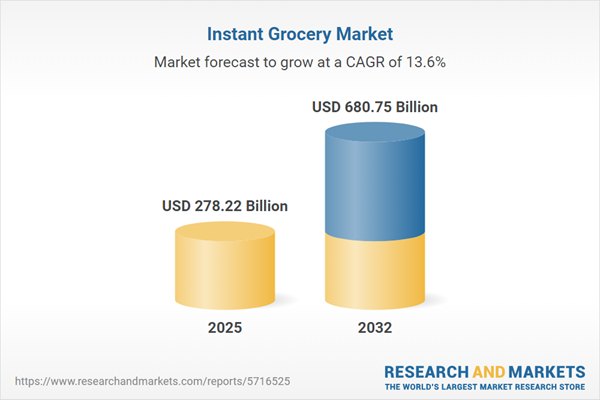Speak directly to the analyst to clarify any post sales queries you may have.
The instant grocery market is transforming organizational priorities across retail, technology, and supply networks. Shaped by rapid digitalization and shifting customer demands, the sector pushes leaders to rethink business models and accelerate operational modernization.
Market Snapshot: Instant Grocery Market Size and Growth
In the last year, the instant grocery market demonstrated robust expansion, increasing from USD 245.40 billion in 2024 to USD 278.22 billion in 2025, with growth projections pointing toward USD 680.75 billion by 2032 at a compound annual growth rate (CAGR) of 13.60%. Key factors contributing to this upward trajectory include consumers’ expectations for immediate access to groceries, the mainstreaming of digital commerce infrastructure, and industry-wide investment in process innovation. The focus on seamless fulfillment, increased investment in advanced technology, and a relentless drive for service reliability underscore the market’s dynamic evolution. Stakeholders are now actively prioritizing agility and scalable strategies to keep pace with rapidly changing consumer behavior and maintain competitiveness in a volatile market landscape.
Scope & Segmentation: Navigating Key Industry Dimensions
This analysis supports senior decision-makers by providing comprehensive benchmarking and growth perspectives across core operational domains. Key segmentation areas and their strategic value include:
- Product Types: The report evaluates categories such as beverages, dairy and eggs, fresh produce, frozen foods, meat and seafood, pantry staples, snacks and confectionery, and household goods. This helps optimize assortment selection and expansion plans aligned with consumer trends and supply considerations.
- Distribution Channels: Analysis addresses hybrid, offline-only, and online-only distribution, equipping executives to adapt strategies to distinct customer behaviors and varied regional requirements.
- Order Channels: Assessment of mobile apps, telephone, and web-based platforms enables organizations to prioritize digital engagement channels that increase market reach.
- Delivery Options: The evaluation of click and collect, express delivery, locker pickup, and standard fulfillment facilitates flexibility in responding to differing delivery timelines and consumer expectations.
- Packaging Types: Insight into reusable versus single-use packaging supports alignment with sustainability initiatives and cost control objectives, important for both compliance and consumer perception.
- Subscription Models: Review covers annual, monthly, and pay-as-you-go services, essential for building retention and encouraging predictable purchase cycles.
- Payment Methods: The research analyzes cash on delivery, card payments, digital wallets, and net banking, informing adaptation to local transaction patterns and market preferences.
- Regional Coverage: The study explores the Americas, Europe, Middle East and Africa, and Asia-Pacific, enabling executives to size opportunities and address regulatory or operational risks unique to each territory.
- Company Developments: Detailed coverage of leading players—such as Gopuff, Getir, Gorillas, Flink, JOKR, Zepto, Delivery Hero, Reliance Retail, Zapp, and Blinkit—helps benchmark competitive strategy and monitor key innovations shaping sector performance.
Key Takeaways: Strategic Insights for Senior Leaders
- Retailers, operators, and suppliers are strengthening operational resilience through investments in modern inventory systems and efficient logistics, directly enhancing customer experience and fulfillment speed.
- Adoption of artificial intelligence and machine learning tools empowers organizations to refine demand forecasting and personalize offerings, ensuring higher service quality and operational agility.
- Environmental priorities increasingly drive choices around packaging and supplier engagement, supporting broader sustainability agendas while addressing compliance and managing reputational risk.
- Partnerships with last-mile specialists and local producers enable organizations to mitigate supply chain vulnerabilities, especially in densely populated or high-growth regions.
- Digital-first and hybrid business models help companies quickly adjust to fluid market dynamics, unlocking new consumer segments and supporting regional growth initiatives.
- Emergent technologies, including autonomous delivery and local fulfillment solutions, are gradually shifting operating models, with a focus on cost management and service adaptability.
Tariff Impact: Addressing Cost and Supply Chain Disruption
In the United States, newly introduced tariffs are creating complexity within instant grocery supply chains. Companies are addressing these challenges by diversifying their supplier networks, adjusting sourcing practices, and forming strategic joint ventures to maintain operational continuity. Many are evolving inventory strategies by blending just-in-time logistics with contingency reserves, particularly in sensitive categories like perishable goods and packaging. These adaptations help organizations preserve reliability and manage costs amid ongoing market shifts and policy changes.
Methodology & Data Sources
The report uses a rigorous approach integrating executive interviews, insights from logistics experts, and analysis of respected industry publications. Primary transaction data from digital grocery channels, studies of geospatial customer behavior, and expert validation ensure the findings are actionable and sector-relevant.
Why This Report Matters
- Supplies data-driven insights that inform capital allocation and strategic prioritization in an evolving instant grocery environment.
- Allows executive teams to better anticipate evolving regulations and support deployment of emerging technologies in dynamic supply chains.
- Provides actionable intelligence for capturing new market opportunities and strengthening competitive positioning.
Conclusion
The instant grocery market is advancing through digital innovation and agile business strategies. Leaders who actively apply these insights will strengthen their resilience and drive sustainable growth within a competitive sector.
Additional Product Information:
- Purchase of this report includes 1 year online access with quarterly updates.
- This report can be updated on request. Please contact our Customer Experience team using the Ask a Question widget on our website.
Table of Contents
3. Executive Summary
4. Market Overview
7. Cumulative Impact of Artificial Intelligence 2025
Companies Mentioned
The companies profiled in this Instant Grocery market report include:- Gopuff, Inc.
- Getir Tasimacilik Hizmetleri A.S.
- Gorillas Technologies GmbH
- Flink SE
- JOKR Holding B.V.
- Zepto PVT Ltd.
- Delivery Hero SE
- Reliance Retail Ventures Limited
- Zapp Market Holding Ltd.
- Blinkit Private Limited
Table Information
| Report Attribute | Details |
|---|---|
| No. of Pages | 188 |
| Published | October 2025 |
| Forecast Period | 2025 - 2032 |
| Estimated Market Value ( USD | $ 278.22 Billion |
| Forecasted Market Value ( USD | $ 680.75 Billion |
| Compound Annual Growth Rate | 13.6% |
| Regions Covered | Global |
| No. of Companies Mentioned | 11 |









